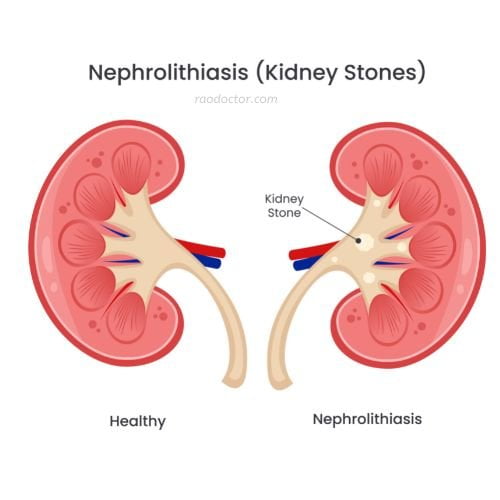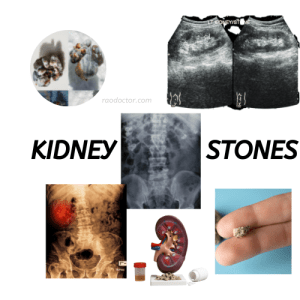Learn all about kidney stones and how they can affect you

Listen to this article-
Kidney stones are small, hard deposits that form when your urine has excess minerals or salts. These minerals and salts then bind to create solid mineral deposits.
Although these may not seem like a big deal, they can be quite painful if they grow large enough to block the urinary tract.
If you have been diagnosed with kidney stones, it is important to know what this means and how to move forward. Let’s take a look at some information on kidney stones and what you should do next.
In my previous post on kidneys, I had made a passing reference to kidney stones- in this article we will discuss all about it.
What Are Kidney Stones?

A kidney stone is a small, hard deposit that develops in the kidneys. Kidney stones form when the urine contains more minerals or salts than can be removed by the kidneys.
These minerals bind with other chemicals in the urine to create solid mineral deposits. There are two main types of kidney stones: –
Calcium stones:
85% of kidney stones are calcium stones. They are most common among people aged 40-60 years. Calcium can bind with other chemicals like oxalates from foods, in the urine and form small crystals, which slowly grow and bond together. Over time, these crystals become stones that lodge in the kidneys or urinary tract.
These are spiky hard stones that are blood tinged due to bleeding caused while traveling down the ureter.

Uric acid stones:
These stones account for 15% of kidney stones. They are more common in people who have a high-protein diet, are overweight, or are on certain medications.
Uric acid is a normal chemical in urine and is metabolized by bacteria in the kidneys. People with high levels of uric acid in their urine may not have enough bacteria to metabolize all of it.
These are smooth soft stones and cause less pain. Sometimes they are large enough to cover the pelvis of the kidney [as shown above] and are called staghorn calculus.
These people have defective protein-purine-metabolism, causing overproduction of uric acid. People suffering from gout are more prone to uric acid stones.
Why Do People Develop Kidney Stones?
There are a number of reasons why people develop kidney stones. The most common cause of kidney stones is dehydration, so it is important to remain hydrated and drink plenty of water.
Other causes of kidney stones include –
- genetics,
- diet,
- medications, and
- various illnesses.
What are the genetic causes of Kidney stone formation?
- Certain inherited metabolic disorders, such as cystinuria, can lead to kidney stones.
- Hypercalciuria, which is an inherited abnormality of calcium metabolism, is another cause of kidney stones.
- Genetic variations in certain proteins may lead to kidney stones.
- Primary hyperoxaluria, an inherited disorder of oxalate metabolism, can cause the formation of kidney stones.
What are the Dietary causes of Kidney stone formation?
- Excess Intake of calcium
- High intake of animal proteins
- High intake of sodium
- Low intake of fluids
- Low intake of magnesium
- High intake of oxalate-rich foods (such as spinach, nuts, and rhubarb)
What medications can cause kidney stone formation?
- Certain diuretic medications, such as hydrochlorothiazide
- Certain calcium-based antacids
- Cyclosporine, a medication used to prevent organ transplant rejection
- Calcium supplements
- Certain antibiotics, such as ciprofloxacin
Which diseases can cause kidney stone formation?
- Gout
- Hyperparathyroidism
- Medullary Sponge Kidney
- Renal Tubular Acidosis
- Cystinuria
- Hyperoxaluria
- Uric Acid Nephrolithiasis
- Dent’s Disease
What are distinct types of kidney stones and how are they formed?
There are two distinct types of kidney stones: calcium stones and uric acid stones.
Calcium stones: 85% of kidney stones are calcium stones. They are most common in people aged 40-60 years. Calcium can bind with other chemicals in the urine and form small crystals, which slowly grow and bond together. Over time, these crystals become stones that lodge in the kidneys or urinary tract. –
Uric acid stones: These stones account for 15% of kidney stones. They are more common in people who have a high-protein diet, are overweight, or are on certain medications. Uric acid is a normal chemical in urine and is metabolized by bacteria in the kidneys. People with high levels of uric acid in their urine may not have enough bacteria to metabolize all of it.
There is another type of not so common stone caused due to cystinuria and are called cysteine stones.
Signs and Symptoms of Kidney Stones
Kidney stones can be uncomfortable and even painful, but the good news is that they can be managed and treated. Knowing the signs and symptoms of kidney stones is key to getting the right diagnosis and finding relief.
Common signs and symptoms of kidney stones include
- constant pain in the lower back or side, pain that radiates to the groin area and abdomen,
- bloody or cloudy urine,
- nausea and vomiting,
- and fever and chills.
If you experience any of these symptoms, it is important to seek medical attention as soon as possible. If a kidney stone is identified, your doctor will likely recommend an imaging test [described below] to get a better look at the stone and decide the best course of action to remove it.
In some cases, a special diet or medication may be recommended to help break down the stone before it passes naturally. Knowing these signs and symptoms of kidney stones can help you get the right diagnosis and treatment quickly, so you can get back to your healthy life.
What are the investigations to diagnose kidney stone?
Blood, urine, and imaging tests can confirm a diagnosis of a kidney stone. Your doctor may suggest these tests
Blood test: A blood test like serum uric acid levels, serum creatinine to check for signs of kidney damage can help your doctor rule out other causes of your symptoms.
Urine test: A urine test can help your doctor check for signs of infection and see if there are any minerals or chemicals in your urine that might cause a kidney stone.
Imaging test: An imaging test can show your doctor if you have a kidney stone. This can be done through a CT scan, an ultrasound, or an x-ray.


Treating Kidney Stones
If you have a small stone that has not yet moved into the bladder, you might be able to pass it at home. Drinking lots of fluids, including water, cranberry juice, or decaffeinated tea, can help break down the minerals in the stone and make them easier to pass.
You might want to drink a lot of fluids if you have a lot of pain or if the stone is blocking urine flow. Your doctor may also prescribe medications to help ease your symptoms.
If you have a large kidney stone that has already moved into the bladder, you will need to see a doctor to have it removed.
There are a few different treatment options for kidney stones, including diet changes, medication, and surgery. Surgery may be in the form of lithotripsy through a cystoscope or by laser and these are reserved for large stones or stones above 4mm.
Small stones can also be flushed out by dissolving them. Homeopathy and ayurvedic medicines are very effective in such situations.
Useful resources-
2.https://my.clevelandclinic.org/health/treatments/16582-shockwave-lithotripsy
How To Reduce Your Risk Of Developing Kidney Stones
If you have been diagnosed with kidney stones, there are a few ways that you can reduce your risk of developing another one: –
Drink plenty of water: In general, the more fluids you drink, the better hydrated you will be. This can help prevent kidney stones from forming and make them easier to pass if you have them.
Stay active: Exercise is not only good for your physical health, but it can also help reduce your risk of kidney stones.
Manage your diet: If you have a family history of kidney stones, you might want to consider making some dietary changes.
Limit your intake of protein: Having a high-protein diet is linked to a higher risk of forming uric acid stones. –
Limit your intake of sodium: Eating a diet high in sodium can increase your risk of forming calcium stones.
Conclusion
Kidney stones are small, hard deposits that form when your urine has excess minerals or salts. These minerals and salts then bind to create solid mineral deposits.
Although these may not seem like a big deal, they can be quite painful if they grow large enough to block the urinary tract.
If you have been diagnosed with kidney stones, it is important to know what this means and how to move forward. Follow these tips to help ease symptoms and prevent future stone formation.
Final Words-
If you have found this article useful, could you please share it on your social media or click below if you have Twitter account-
You've Been Diagnosed with Kidney Stones: Now What? Share on XMy next article will be on another urinary tract problem- The Overactive Bladder
Disclosure-
Some of the links used in this article are affiliate links. i.e., if you sign up for their paid program or make a purchase, I will get a commission, at no extra cost to you. Please be rest assured that I only recommend software/ products I genuinely believe in, and trust to be good for you too

